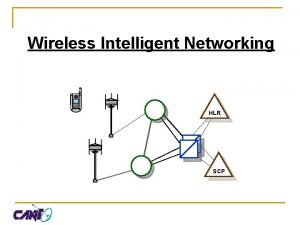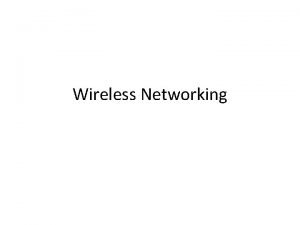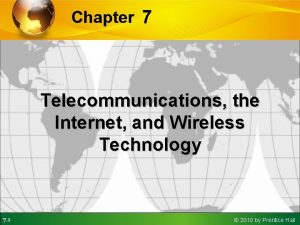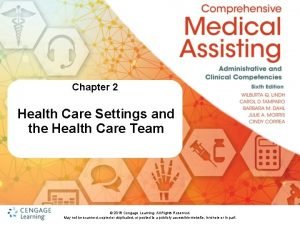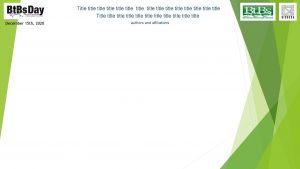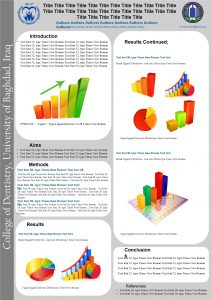SOURCE TIA TITLE Wireless Networking for Healthcare Environments




- Slides: 4

SOURCE: TIA TITLE: Wireless Networking for Healthcare Environments AGENDA ITEM: GRSC 4 5. 8 CONTACT: GSC 11_GRSC 4_40 National Institute of Standards & Technology (NIST) Wireless Networking for Healthcare Environments GSC: Standardization Advancing Global Communications 1

Wireless Network Protocols for Healthcare Environments n 802. 11 b Wi. Fi. TM n 802. 15. 4 Zigbee 802. 15. 1 BT 802. 11 b Wi. Fi. TM 802. 3 Ethernet 1000 base-T 1000 Data Rate (Mb/s) 100 10 802. 15. 3 a 802. 15. 3 1 0. 1 Personal Area 802. 16 a 100 base-T Local Area 802. 3 Ethernet 10 base-T 802. 20 Metro Area 802. 15. 4 Zigbee 10 – 30 m 10/25/2021 100 -300 m n The significant advancement and proliferation of wireless data technologies creates entirely new areas of applications. Of particular importance is the potential impact of next generation wireless technologies on healthcare delivery. Goals Evaluate performance of protocols for wireless medical devices in clinical environments n Improving the safety and efficiency of medical device wireless communication and operation n 802. 11 g 802. 11 b 802. 15. 1 Bluetooth 0. 01 802. 11 n 802. 11 a Motivations 3 – 10 Km ANTD Programs 2

Wireless Network Protocols for Healthcare Environments Patient n Developed application scenarios and theoretical service data rates. n Supplied service data rates as reference data on the support of various wireless technologies (IEEE 802. 11, 802. 15. 1, and 802. 15. 4) for select medical applications (e. g. , ECG) and scenarios defined for use in the IEEE 1073 guidelines on Central Monitor Stations n Patient Po. CD MAC Access Delay (seconds) 0. 008 BT DH 5 Packets BT DM 5 Packets 0. 006 BT DH 3 Packets BT DM 3 Packets 0. 004 BT DH 1 Packets BT DM 1 Packets 0. 002 0 1 2 3 4 5 6 Number of Patients 10/25/2021 Accomplishments 7 Radio Frequency (RF) usage in a medical environment 8 ANTD Programs 3

Wireless Network Protocols for Healthcare Environments Protocol Evaluation and Development A hostile environment for radio communications Goals Can existing and emerging wireless technologies be used in a medical environment? What are the unique interoperability, security, coexistence, and performance requirements for medical applications? Will proprietary solutions impede interoperability? Will multiple solutions cause even more market fragmentation and hinder fast deployment? Technical Approach n n n Knapp Medical Center Customers and Collaborators Standards Development Organizations n IEEE 1073 (Medical Device Communications) n IEEE 802 (Local Area Networks / Metropolitan Area Networks) n ISO/TC 215 (Health Informatics) Industry Consortia n Bluetooth Special Interest Group n Health Level Seven (HL 7) n Wi. Fi n Wi. Media n Zigbee Alliance Simulation and Modeling Suppliers and Researchers n OPNET (network simulation software) n Telelogic (protocol simulation and verification software) Government Users n U. S. Food and Drug Administration (FDA) n U. S. Veterans Administration (VA) 10/25/2021 Define relevant performance evaluation metrics to characterize medical application requirements in terms of throughput, delay, jitter, and packet loss. Establish theoretical bounds on the network transport service capabilities of candidate WPAN and WLAN technologies. Conduct performance evaluation including theoretical analysis and protocol simulation for medical scenarios of interest. Research Plans n n n n n Define select medical environment evaluation scenarios including device type, number, location, and application types. Translate medical application requirements into network transport service requirements. Obtain theoretical bounds for wireless technologies capabilities in terms of throughput, delay, and coverage. Develop theoretical and simulation models to evaluate the performance of various wireless technologies for defined medical and healthcare scenarios. Run simulations for defined medical environment scenarios and compare theoretical bounds and simulation results. Extend modeling framework to investigate co-located heterogeneous wireless technologies for medical devices and investigate mutual interference. Develop coexistence techniques and provide feedback to both medical device and wireless technologies standard organizations. Contribute results and findings to medical device standard organizations (e. g. , IEEE 1073). Participate in wireless technologies standard organizations to learn protocol features and contribute to development of extensions (e. g. , IEEE 802). Publish evaluation tools and performance results. ANTD Programs 4

